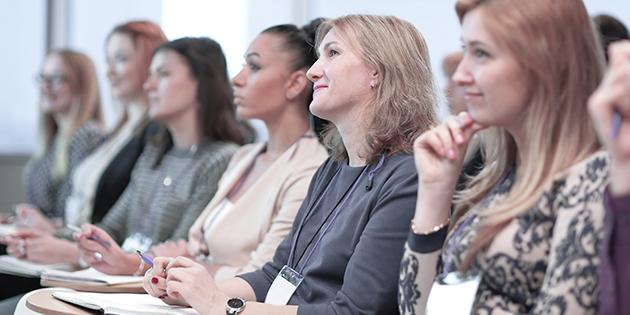
SmartPhotoLab/Shutterstock
Women make up a significant portion of higher education overall. However, in comparison, fewer women are represented in leadership and senior administrative roles. Providing women with tools for articulating their value and identifying career goals are just a couple ways the Women’s Initiative for Professional Development at University of California is responding to the needs of women in higher education. In this interview, Teresa Barton details her experience with the program and provides advice for others seeking to implement similar initiatives.
Kelly Cherwin, HigherEdJobs: Ms. Barton, the University of California (UC) created a Women’s Initiative for Professional Development. Please explain how the creation of this program transpired?
Teresa Barton, Director, Systemwide Career and Development Programs, UC Office of the President: The program was created in response to employee engagement survey results, as well as other data, that showed that we needed to elevate women in their careers at UC. Women make up over half of our workforce, yet they represent less than half of leaders at higher levels. The program was developed in partnership with the Systemwide Advisory Council on the Status of Women, Systemwide Human Resources, and our external partner Coro Northern California. The program is also sponsored by University of California President Napolitano.
Cherwin: The program is aimed for mid-career faculty, academic personnel, and staff from across the UC system. What are the major goals of the program and how can the program help mid-career professionals and academics?
Barton: The program focuses on what I call personal, professional development — meaning that we are not teaching participants specifically about managing or how to be a leader. We are providing them with tools that help them articulate their value to the organization, help them advocate on their behalf, and identify what their future career plans may look like. The program has been designed to:
- Cultivate a professional network of women that spans the UC system
- Give women access to top UC leaders — women and men — so they can interview and learn from them about their diverse leadership approaches and journeys
- Strengthen skills and confidence through hands-on practice with a range of tools and skills in the areas of:
- Professional development and impact
- Strategic relationship building
- Developing and delivering a compelling narrative regarding one’s professional accomplishments and vision
- Negotiating at work
- Peer coaching
Cherwin: In your presentation on this topic at the recent CUPA-HR 2019 conference, you mentioned that the program doesn’t teach how to manage or lead, but promotes professional development. Please elaborate more on this and explain why this is significant.
Barton: This is significant because employee engagement survey results indicated that women did not think they could achieve their career goals at UC. We wanted to develop a program that would change that and elevate women in their UC careers, whatever those careers may be. We did not want to continue the assumption that the only way to progress in a career is through a management or leadership track. The program is open to women who are people managers and those who are not. The focus of the program, as I mentioned, is to give participants tools to help them identify what they want in their career, make their value known, and advocate for themselves. There is much research available that shows women do these things far less than their male counterparts. We wanted to change that.
Cherwin: You stated there is significantly more interest in the UC Professional Development program than capacity for participants. In one respect that is impressive that the program has such a demand, but on the other hand, do you think this shows that there is an underlying issue with the support and development that women in higher education are receiving?
Barton: In regards to UC, with a workforce of over 200k, and half of those being women, the number of women eligible to attend the program far outnumbers the seats we can offer. In addition, I think the program is in high demand because it is a unique program at UC and within higher education. Rarely will you see managers and non-managers across academic and non-academic disciplines across multiple levels of the organization attending the same development program. We’ve seen that this offers additional learning, develops networks of people who would not normally interact, and helps with an overall understanding of UC as a whole.
Cherwin: What are the top suggestions you would offer to another campus that may want to implement a women’s professional development program?
Barton: I would find partners and sponsors who see the vision and can move it forward, those may be internal to the organization or external. We partnered with Coro Northern California because we were already working with them to offer a variety of programs across the system. They helped identify the key development areas and brought a perspective that looked beyond the university. I would also say, do your homework. See what the need is at your institution and start where you can. A small effort can be multiplied. In the case of the UC Women’s Initiative, we started with a pilot of 22 in the first year, then scaled it to 60 in the second year and scaled it to 180 in the third year. 2020 will be the fifth anniversary of the program, and we are still looking at ways to evolve.
Cherwin: What growing pains has the program experienced along the way and/or learned lessons or initiatives that you did not expect?
Barton: Well, scale has been a concern since the beginning and still is. How can we open the program to more women without diminishing its impact? For a program this size, logistics are always a challenge, so we have long lead times to confirm locations and that can present a problem when you are booking a year in advance. We do have attrition, so having a ready list of alternates is important since we are asking participants to commit up to a year in advance in some cases, schedules change, and we need to find replacements. The nomination process and participant communication are other areas that can present issues, but those are topics unto themselves so I won’t go into them here.
I will say getting the word out about the program was difficult at first; UC is a decentralized organization and advertising the program is difficult. Now that we’ve had over 430 women go through the program, we use them as ambassadors and that has helped communicate more broadly across the organization.
Cherwin: Your program purposefully tries to ensure all participants are on the same leveled playing field and feel comfortable, so titles and bios are not published until after the first session. This is a wonderful tactic. What feedback have you’ve heard from participants regarding the value of this strategy?
Barton: This has been the most surprising for me in terms of feedback. Overall, they like it. Even when we have participants asking for bios etc. before the program, once they experience it, they understand and say they are glad they didn’t have them ahead of time. The focus is on being a woman at UC and the experiences we share that are similar and the experiences we have that are completely different. We do this to help alleviate imposter syndrome or the sense that “I don’t belong here.” We wait until after the first session to provide bios so participants have an opportunity to connect without title or level getting in the way.
Cherwin: I think it is interesting to evaluate participants’ expectations prior to entering the program and the results of the program once they’ve experienced it. What are some ideas that any of your participants thought of prior to starting the professional development program and did they have any key takeaways once they completed the program?
Barton: What comes to mind is feedback we received from two different women, from two different cohorts. One said she came to the program thinking she was winding down her UC career and she left the program seeing new opportunities ahead for her. The other was a faculty member who had taken on a role in administration. She wasn’t quite sure what to expect going into the program. At the end, she realized that despite liking her role leading the department, her true passion was in research and she was going to make a move back to research and teaching. There are many stories like this, which I think points directly back to the purpose of the program — elevating women in their UC careers. These two women may have left the university, but now they are staying and are reinvigorated.
Cherwin: You use the OARR system in your programs. Please explain what this is and how it helps improve effectiveness of the programs?
Barton: OARRs is a tool that helps organize meetings by planning out what outcomes, agenda, roles, and responsibilities are needed. It is a simple tool and can be used in a variety of ways. We’ve had participants say they’ve used it to plan meetings, training sessions, difficult conversations with team members, and we had one person say she used it to talk with her team about reorganizing.
It helps improve the effectiveness of the program because we have an OARRs for the overall program which we refer to during every session to ensure we are meeting our goals. It provides a framework that makes the objective of the program clear so that everyone knows what to expect.
Cherwin: In a previous HigherEdJobs interview, the topic of work-life balance was discussed and in particular, how the term “balance” is an “unreasonable term that perpetuates much of the gender inequities we are trying to dismantle.” What are your thoughts on the idea of balance and is this topic discussed in the UC professional development program and if so, how?
Barton: The idea of balance is discussed during the program in a variety of ways. We have outside readings that discuss the gender inequities and the additional demands on women of color in this area, and the topic is discussed during leader interviews (we interview men and women leaders). Interestingly, this topic comes up during our male interviews as well. It is a struggle for working professionals in general. I think the key to achieving some semblance of balance is to know what your limits are and advocate for yourself. That is what we teach in the program, and what many of our interviewees provide as advice.
Cherwin: You are the Director of Systemwide Career and Development Programs at University of California. What keeps you engaged in working in human resources in higher education?
Barton: I came to higher education after over 20 years in private industry. For me, knowing that the work I do is ultimately supporting students and having an impact on the world at large is really motivating. The University of California is one of the leading research institutions in the world, the work we do has a broad impact. I am also energized by the colleagues I work with on my team and across our 18 locations systemwide; they are an accomplished group, great collaborators, and willing partners.
